Displaying items by tag: Round Ireland Record
Round Ireland Record Update (0700): Gavignet Eyes Record Time As Trimaran Surfs off Donegal
#roundirelandrecord – The Sultanate of Oman's MOD70 Musandam-Oman Sail has rounded the top of Ireland and was hitting 20–knots off the coast of Donegal in a bid for the 20–year–old Round Ireland Speed sailling record early this morning. Having started on Dublin Bay last night at 1800 hours and headed north, the current ETA back on Dublin Bay is scheduled for tomorrow (Wednesday) morning which means the record could fall by as much as ten hours. At 0730, as the big French–based Tri passed Bloody Foreland, the international crew were steering 284 degrees and heading deep offshore.
French skipper Sidney Gavignet was reunited with his three Omani crew Fahad Al Hasni, Yasser Al Rahbi and Sami Al Shukaili who were key members of his triumphant team when Musandam-Oman Sail smashed the Round Britain and Ireland world record last August and now it looks like the 1993 Round Ieland record set by Steve Fossett on Lakota may now also be in doubt.
The National Yacht Club is the base for the record bid and Irish World speed Sailing Commissioner Chris Moore is officiating.
Also on board the Tri is Spanish sailor Alex Pella and the French multihull veteran Jean Baptiste Levaillant who have joined the Omani trimaran for the attempt to beat the long standing Round Ireland record of 44 hours set back in September 1993.
"The goal is to give my Omani crewmates some real life training in a range of conditions and we are taking advantage of an ideal weather window," explained Gavignet who was last on the boat when he raced it single-handed across the Atlantic in the Route du Rhum in November 2014.
The forecast before they threw the lines at 17:04 UTC on Monday was for light conditions that were scheduled to build significantly overnight. Before casting off, Sidney warned that they would be playing it safe: "We will be watching the weather carefully and avoiding risks."
Musandam-Oman Sail made an attempt on the Round Ireland record two years ago but were forced to abandon due to unsafe conditions but hopes are high that this time, the weather will be kinder and allow Oman Sail to add this speed record to their growing collection.
"The current record is held by great sailors, so it would be a huge source of pride for us to break it and add such an achievement to our experience as sailors. We are expecting a lot of challenges and very low temperatures to the north, but we are prepared and hope to return with another record for Oman," said Fahad Al Hasni.
"We are focussing this season on the sailor's strength and fitness, but also on preparing the boat and studying the weather to make them better all round offshore sailors. There won't be many record attempts on our schedule in 2015, but this one is a primary goal and if we can get the record, it would be very good for the guys, for the country and for Oman Sail," added Gavignet.
Since the boat was launched following a routine refit, Gavignet has been training with his crew in Lorient and taking part in the Grand Prix Guyader in Douarnenez in Brittany, France, where they flew the Omani flag in Europe for the first time this year and got back into competitive racing mode after a winter sailing with other crew in other boats.
Read more about the history of the Round Ireland Speed Sailing Record
Foxall & Mod 70s Sail Away, Beaten Again By Irish Winds
#rdp13 – There is further disappointment this morning as the much hoped for challenge to the Round Ireland speed sailing record has been scrapped. Last night, Route des Princes organisers admitted the weather window to beat the long standing 44-hour Round Ireland record had been missed.
Organisers confirmed an attempt in May. Last week, Afloat.ie had signalled the weekend opportunity for a Round Ireland attempt since last Wednesday.
Forecasts for today (Monday) show only light winds which means even these ultra fast boats could not make a record time.
Instead, the fleet will sail a newly configured course to Plymouth with a measure of flexibility built. in The extreme easterly turning mark may be as far up the Channel as Southern Head off Newhaven, East Sussex. There are three other choices at Nab Tower, Fairway and Shambles. The longest possible course is 850 miles and the shortest is 650.
It is the second time this year that Ireland's Damian Foxall and the team of Omansail have ditched plans for an attempt on the Round Ireland speed sailing record. Foxall and the crew came to Ireland in March for a dedicated attempt but were beaten back by gales on the Welsh coast. For now, the 20–year record set by the late adventurer Steve Fossett on the Lakota Catamaran lives on. Perhaps Foxall and Omansail might make it third time lucky sometime soon?
Last Call for Round Ireland Record Attempt?
#rdp13 – The low pressure area which currently dominates Ireland's weather has speeded up slightly in its eastward movement, and any of the big multihulls in Dun Laoghaire which wish to avail of this useful weather window for a round Ireland record challenge would have to think in terms of leaving the harbour at dawn tomorrow (Saturday) writes W M Nixon.
The situation is fairly clearcut. A successful attempt will require the boat to be at Malin Head at much the same time as the centre of the low is due north of Malin Head. Ideally perhaps, the challenger would aim to be at Malin slightly in advance of the low being due north, in order to avail of the last of the southwesters to make some westing into the open Atlantic before the wind veers rapidly.
On the latest forecasts, the centre of the low will be north of Malin Head between noon and 1300hrs Saturday. From now until then, winds over the entire coastline of 170 miles between Dublin Bay and Malin Head will be fresh occasionally strong southwesterly. In conditions like that, with relatively smooth water, a MOD 70 would expect to average 25 knots, giving a sailing time of around seven hours, indicating a departure from the Kish no later than 0500 hrs.
The wind tomorrow afternoon is then expected to quickly become a near gale from the northwest off Ireland's northwest coasts. Too much wind is as much a hindrance for record times as too little. But there's a chance that any boat on line for a successful record challenge will have covered a substantial distance down the Atlantic seaboard before the swell has increased sufficiently to hamper progress.
Saturday Afternoon Should Be Go for Round Ireland Record
#rdp – Saturday afternoon is now shaping up as the optimal time for the multihulls in the Routes des Princes to start their round Ireland record challenge from the Kish Lighthouse writes W M Nixon, while the planned start on Monday looks even less favourable for a successful attempt.
Of course, today's large multihulls outperform the boats of twenty years ago by so much that they could still break Lakota's 15.84 knots average from 1993 for the 704 mile circuit in conditions which are only reasonably favourable. But a boat leaving the Kish heading anti-clockwise round Ireland around 1500hrs on Saturday should comfortably average 20 knots plus in totally favourable fresh to strong sou'westers for the 170 miles to Inishtrahull. In fact, a skipper knowing the speed and performance potential of his boat in these ideal conditions will be keen to leave at the latest possible time, and yet still reach Inishtrahull at midnight Saturday, as any hours chopped off from the start will stand to the good as they close for the finish back towards the Kish through Sunday night.
Up at Inishtrahull towards midnight on Saturday, a low of 989 easing to 991 will pass over the Malin Head area, and behind it strong nor'westers will firm in very quickly. The problem then will be not to damage the boat on the next stage from Bloody Foreland to Erris Head as she tries to make speed straight into old head seas running in from the southwest. But with every mile made good southwards down Ireland's Atlantic seaboard, this problem will ease and better speeds can be maintained.
The usual hassle with getting past the Blaskets should be minimal in a good nor'wester which can the be carried all the way back to the finish, hopefully with the boat being able to fetch up the final 70 miles from the Tuskar to the Kish. It can't be overlooked, however, that the low, having filled to 1005, is indicated as coming to a halt over the North Sea on Sunday evening. This will cause a distinct easing of wind pressure over the entire area, but by that time any boat which started on Saturday afternoon will be within sight of the finish, and the Holy Grail of the 36 hour circuit.
#RDP – The nine multihulls in the Route des Princes fleet have only just reached Dun Laoghaire this morning in that special stage of exhaustion brought on by struggling in light airs and calms in boats that can fly with half a decent breeze. And now they plan to have several days of R & R (relatively speaking) before a planned joint assault on the Round Ireland Record starting at the Kish Lighthouse on Monday writes W M Nixon.
Until late yesterday, forecast conditions were looking quite good for the record challenge early next week. And they still do. But in the approaching volatile spell of weather which is going to make for a very miserable rainy weekend for all of us, dare one suggest that late Friday night/early Saturday morning offers a better potential for a shot at the title?
There's a nasty little low forecast to be zapping across the north of Ireland through Saturday, currently predicted to be tracking east with its centre expected at 1400hrs Saturday right on Malin Head. It should be quite vigorous, as it will be down at 985 when 350 miles west of Malin Head at 1800 hrs Friday, though it will have eased a bit to 990 at Bloody Foreland, 991 at Malin Head, and 993 at 1800hrs Saturday over the Mull of Kintyre.
Thus a boat leaving the Kish anti-clockwise at a carefully calculated time from midnight Friday onwards has a good chance of very fast sailing on smooth seas with south to southeast winds off the land all the way to Malin Head. The key to it all will be calculating when precisely to leave, in order to minimize any time going to windward off north Donegal, or even sitting becalmed in the centre of the low before the northerlies behind it set in big time on Saturday evening to blast you right down the west coast.
They're set to back steadily, which would give straight line sailing from the Fastnet to the Tuskar, and then, with a bit of luck, close-reaching in a wind just off the land from the Tuskar back to Dublin Bay on Sunday morning.
Beyond that, things don't look too bad for a clockwise challenge on Monday with the winds mainly nor'westerly. The problem is that, as things look now, a quite determined ridge of high pressure is shown as building northeast towards Ireland through Monday, which should make for some very gentle and summery weather down in West Cork and Kerry.
God knows they deserve it down there after some of the weather they've had in recent days. But gentle calm summer weather isn't great for record breaking. So doubtless this morning in Dun Laoghaire, some crews will be seriously considering the small-hours-of-Saturday option, if they're allowed.
It would make it more interesting if two different challenges were on offer - one Friday midnight onwards, and the other the proposed one on Monday. And it would be a logistics challenge for the official time keeper too. Perhaps somebody should be thinking about kitting out the former keepers' bedrooms on the unmanned Kish Lighthouse so that Chris Moore, keeper of the records on behalf of the National YC, could take up residence out there for a few days, starting Friday. It would be a real fun way for the former NYC Commodore to spend the mid-summer weekend.
Click here for a history of Round Ireland Speed Records
Round Ireland Speed Sailing Record Times
#roundirelandrecord –The idea that sailing round Ireland could be sport would have seemed crazy not so very long ago. Ireland's Atlantic coasts, indeed all Ireland's coasts, were seen as the sole preserve of a skilled and hardy breed, very special seafarers who were the only people able for the dangerously hard work made necessary by the need to make a living from fishing, commercial shipping or naval duties on some of the most restless water in the world.
Maybe we're getting back to that stage, with the professional crew of the MOD 70 Musandam – including Ireland's Damian Foxall - lining up today to take on the still impressive 44 hour round Ireland sailing record set back in September 1993 by Steve Fossett's superb 60ft trimaran Lakota. For they're doing it at a time when winter is refusing to loosen its grip, and the radio stations are broadcasting continuous weather warnings. Sail around Ireland? You wouldn't even have let the dog out of the house yesterday.
Yet at least we now know that it is possible to sail the 704 miles round Ireland at high speed and survive – and sometimes even enjoy it. But in the days when Ireland's Atlantic seaboard was known only to professional seafarers and locals scraping a living with small boats which hoped to scuttle back to shelter when storms threatened, it had a fearsome reputation. It was a viewpoint which those who sailed its waters had a vested interest in encouraging and preserving. It rightly made them heroic to others, while the jealously guarded navigational knowledge of local pilots was something which gave them a useful economic advantage.
In the late 19th Century, however, the spread of recreational sailing inevitably led to cruising yachtsmen sailing to ever more remote coastlines. Mostly they were affluent types whose boats were managed by professional captains. But in time the sportsmen were sailing their own boats, with amateur cruising under sail becoming a whole new branch of yachting. And there had long been yachts on the west coast of Ireland. In the briefly prosperous pre-famine era, the Royal Western YC of Ireland in 1838 listed 18 members' vessels of varying sizes based at its home port of Kilrush in County Clare. So the likelihood is high that some of them sailed round Ireland, even if only on delivery trips by professional crews.
But the earliest specifically round Ireland cruise from an Irish port that we definitely know of didn't happen until 1889, when Walter Boyd of Howth skippered his own 34-ton yawl Aideen round Ireland. Better known as Judge Boyd, Aideen's amateur skipper was a classic Dublin character – he's referenced in Joyce's Ulysses – but his enthusiasm for cruising Ireland's more rugged western coastlines was usually not shared by fellow yachtsmen, even if he did his best to spread the word that it was by no means as scary as popular opinion would have it.
We know little of Boyd's cruise, except that he did it and he must have sailed all the way. It wasn't until 1896 that we have the log of a round Ireland cruise which enables us to give some sort of guess at speed. Of course, the idea of sailing round Ireland non-stop was a complete non-runner until the Round Ireland Race was inaugurated from Wicklow in 1980. But in 1993 it was realised that Lakota's sensational new time was such a game changer that it was important to record the early pioneers before this new wave of multi-hull hyper-speed swept their memory away completely.
Thus it was that, 97 years after he wrote it, the number crunchers fell upon Belfast doctor Howard Sinclair's charming log of his clockwise cruise round Ireland in 1896 in the 30ft cutter Brenda. They worked out – after making allowances for time taken to get in and out of ports and anchorages – that he had averaged 2.63 knots. There were few enough eligible round Ireland circuits after that, for the advent of the auxiliary engine rendered most of the only very slowly increasing number of round Ireland cruises invalid as pure sailing projects. But in 1935, the speed improved slightly when Humphrey Barton – later founder of the Ocean Cruising Club – made an anti-clockwise cruise from Belfast Lough at an average of 3.34 knots in the engineless 37ft gaff cutter Dauntless.
Belfast Lough figures surprisingly prominently in these early round Ireland sailing chronicles. Perhaps it's because, of all the major Irish sailing centres, Belfast is furthest from the choicest cruising area in southwest Ireland. It's as quick for the Belfast men to sail home from Kerry by going on round, whereas Dublin Bay boats are heading further away from home until they reach Slyne Head up in Connemara, and Cork boats seldom if ever sailed round Ireland at all until Denis Doyle came along and cut a mighty swathe with Moonduster.
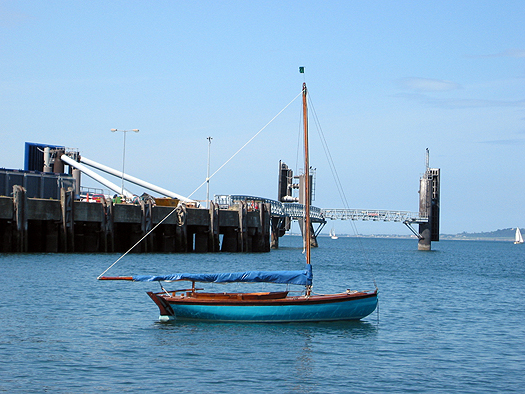
The mighty atom. The Belfast Lough Waverley class sloop Durward is just 18ft long. Yet in 1961 (when setting a Bermudian rig) she sailed round Ireland at an average speed of 3.4 knots. Photo: W M Nixon
Whatever the reason, the next two cruises which increased the average speed both also started from Belfast Lough. Truly remarkable in 1961 was the speedy clockwise circuit by the 18ft Belfast Lough Waverley Class Durward, still the smallest keelboat to have done it, and a record which is likely to stand as keelboats rarely get any smaller. In those days, Durward (which is now based in Dun Laoghaire) set a handy Bermuda rig, whereas today she has changed to the gunter rig as originally designed, with a remarkably long mainboom. On the circuit in 1961, for which her cockpit was fitted with a temporary lid to mke a sort of cabin, she was sailed by brothers Kevin and Colm MacLaverty, with Mick Clarke as third hand, and their average speed with this gallant micro-cruiser was 3.4 knots, very good going with a 14ft waterline.
The average speed finally got above 4 knots three years later in an unintended anti-clockwise sailing circuit. We (this blogger, together with Russell O'Neill and Ed Wheeler) set out in 1964 in the vintage 36ft yawl Ainmara with every intention of availing of the engine as often as needed. But it seized solid before we'd even got clear of Belfast Lough, so it was sail all the way for an average of 4.83 knots which would have been around than 5.4 if we hadn't had to spend a long night lying a-hull in a southerly gale somewhere off the mouth of the Shannon.
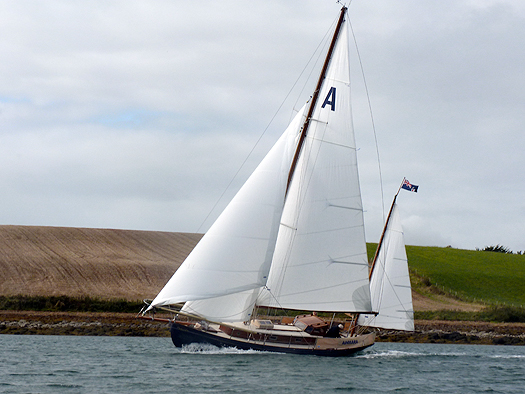
Ainmara, 101 years old, is currently owned by Dickie Gomes, who established a round Ireland record with the trimaran Novanet in 1986. But Ainmara was herself an "accidental" record holder, back in 1964 Photo: W M Nixon
By the 1970s, Round Ireland Races were coming up the agenda, so the record analysts of 1993 had something more tangible to go on. The first round Ireland race was a clockwise three stage two-handed event from Belfast Lough staged by Ballyholme YC, with stops in Crosshaven and Killybegs. Winner was the Dun Laoghhaire S&S 34 (Robert Mollard & Dick Watson), and with many light weather days, they averaged 4.95 knots. Five years later, the pace quickened with the first non-stop Round Ireland Race, clockwise from Wicklow in 1980, and the line honours winner, Johnny Morris from Pwllheli with the 36ft Force Tension, averaged 5.24 knots.
Then, The Doyler arrived with The Duster, and the numbers started to get interesting. The great Denis Doyle of Cork is gone from us now for a dozen years, and many of today's younger sailors can scarcely be aware how this most modest of men, with his lovely Crosshaven-built 1981 Frers 51 Moonduster, so greatly enhanced Irish sailing. And never more so than in his final twenty years, when he and Moonduster played a central role in the European offshore racing scene.
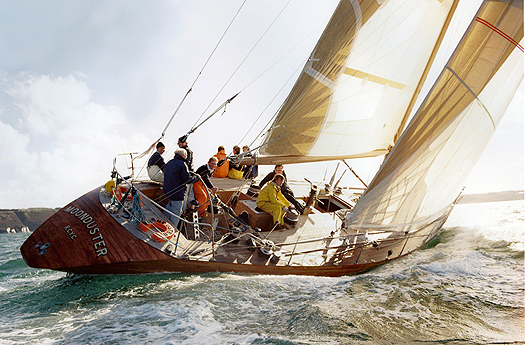
The queen of all fleets. Denis Doyle's legendary Moonduster was the flagship of Irish offshore racing for twenty years. Photo: Bob Bateman
Once The Doyler had decided that the Round Ireland Race and Wicklow deserved his support, he gave it so wholeheartedly that today it receives the same points weighting in the RORC championship as the Fastnet Race itself. Oddly enough, though, Moonduster's two record times in the Round Irelands of 1982 and 1984 were so good that the challenge they posed moved the round Ireland record beyond the Round Ireland Race. For the Round Ireland Race is of course narrowed to a specific starting time, and you have to go clockwise. But after Denis Doyle had pushed his own average speed to 7.09 knots in 1982 up to 8.02 in 1984, inevitably speed sailors began to wonder just how fast you might go with choosing you own optimal starting time, and carefully selecting which way to go.
For there's no doubt that Moonduster's performance in 1984 was a real beauty. The wind was west to nor'west, with enough north in it to comfortably lay down to the Fastnet, and then only the briefest bit of sailing hard on the wind before it backed slightly and they were off on a hack up the west coast. As navigator John Bourke puts it: "We were seeing off an entire Irish county in every watch".
An average of 8.02 knots may seem little enough compared to today's massive multi-hull speeds. But for an amateur-crewed mono-hull sailing at a pre-ordained time on a land-circling course in a region of weather ranging between variable and volatile, it was quite something, and a challenge to all-comers. So although the Round Ireland Race itself continues to have its own monohull record time (it's currently held by Mike Slade's 100ft Leopard from the 2008 race), since 1986 the out-and-out Round Ireland Sailing Record has been held by three different multi-hulls choosing their own starting point and time, and which way to go. One of them did it from Belfast Lough, and the other two did it from the Kish Lighthouse in Dublin Bay, which has become the de facto recognized record starting point, as it was also from here that a new Round Ireland Mono-hull Record was established by Jean-Philippe Chomette's Open 60 CityJet in 2006.
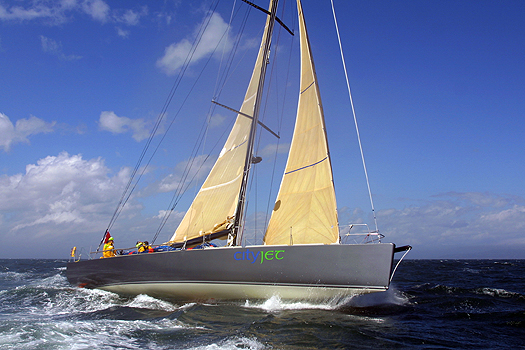
Jean-Phillippe Chomet's Open 60 CityJet set a straight monohull record from the Kish in 2006 Photo: David O'Brien
The weather expert in CityJet's successful crew was noted sailor/meteorologist Chris Tibbs, whose belief that reading the weather right for a round Ireland challenge is one of the most interesting met challenges in world sailing was borne out by the elegant way in which CityJet fitted into a west to nor'west wind pattern to sweep around clockwise in record style, and his analysis of this performance added to the growing knowledge of what's involved.
If you're thinking in round Ireland sailing record terms, first thing is to re-think the shape of the island. The popular perception is that the Emerald Isle is more or less rectangular, with distinctive north, east, south and west coasts, and very clearcut right angle corners at Fair Head, Carnsore Point, Mizen Head, and Bloody Foreland.
Not so, however, if you're in the records business. Anyone contemplating a round Ireland sailing record these days has to think in terms of a jolly green giant tadpole, with its blunt head pointing northeast towards the Inner Hebrides, and the fat tail pointing southwest into the wide blue yonder.
Those who would set a record will plan on as much fast reaching as possible on the longer eastern and western seaboards, and running before the wind around the northern nose, with any slugging to windward as brief as possible around the southerly tail.
So the smart money is on the situation where there's a big low loitering with intent to the southwest of Ireland, and the wind is set for two or three days in the southeast to east quadrant. Just like the last 36 hours, in fact, except that the pressure gradient has been more than a little too steep for record-breaking purposes. But with the isobars easing up a bit this morning, the setup is in place, and the only way is anti-clockwise. That said, there's a small concern that tonight might see a localised southerly twist down towards Mizen Head. But that should have gone back southeast by the time Musandam is getting there, and with any luck they might even get by with just the one tack sou'west of the Fastnet, though windward tacking is not the same problem with the Mod 70s as it was with some of the earlier multi-hulls.
In taking on the round Ireland challenge, it may well be that the alternative winning option of a west to nor'west wind occurs more frequently, which would dictate a clockwise route. But a nor'wester usually doesn't last as long, whereas the rarer sou'east to east wind can settle in for days. Or at least it seems like that at this time of the year, when it's bringing us the tail of Siberian weather, and would drive you nuts if you didn't have some worthwhile project like a round Ireland record on hand to make good use of it.
Of course, a crazily ideal situation might seem to be an intense low stuck right over the middle of Ireland, and you whirl round anti-clockwise, broad reaching on port gybe all the way. It's an interesting gambler's option, and it has succeeded in the past. But maybe it's too unstable a weather situation for serious record-breaking nowadays, because if the low is sufficiently intense to have strong winds all round its core to power the entire coastal sailing route, it can sometimes quickly fill and leave you becalmed, as low pressure areas lose power over the land. But if it does persist, even having its centre move just 50 miles can have the wind all over the place.
No, what you want is a good steady gradient, but not too steep, with winds southeast to east and the occasional bit of luck with slight but significant swings in the wind direction to enable you to make south all the way around the western seaboard without tacking, and east-northeast along the south coast equally free of tacking, once you've weathered the tadpole's tail.
It's a big ask. We can predict the weather fairly accurately a day ahead, but that accuracy is rapidly reducing with every hour beyond the start, when the show up and running and there's no going back. But things are looking good for this new challenge by Sidney Gavignet, Damian Foxall and their shipmates on Musandam, which is now due to start today. Heaven knows, but they could do with a little break. Having left Lorient late Thursday afternoon, they found conditions getting increasingly rugged as they came north, and much of the passage up St George's Channel was under bare poles in a howling sou'easter yesterday, making over to the lee of the Wales and getting into the relative shelter of Caernarfon Bay under snow-covered mountains as evening drew on.
Damian summed it up in a text to Afloat.ie, "A bit bouncy for a start.....shelter in Caernarfon Bay this evening and tonight, nice and flat, chilly though...sleet, snow forecast...option tomorrow morning better, potential start 0900ish. Enjoy your dinner this evening with the family and a bit of telly in front of the fire, we'll be thinking of you ☺"
It was mighty cold, it still is, but spirits were raised with hot food – the first of the day for the skipper and Thomas le Breton. And they have been able to consider their options, with the weather pattern for the next couple of day seemingly fairly clearcut, the wind set in between southeast and east with the occasional slight weaving, which can make a lot of difference at difficult headlands. But with the wind forecast to become locally east to northeast along the south coast between the Fastnet and Carnsore Point on Monday morning, they know they've got to be up and moving promptly this morning if they're going to knock the record for six.

Robin Knox-Johnson's 60ft catamaran British Airways developing power off Dublin Bay at the start of her round Ireland challenge in May 1986. She came within an ace of capsizing a few seconds later, but then streaked away northeastward on a successful anti-clockwise circuit. Photo: Tom Lawlor
So what are the three previous multi-hull records they're taking on? Well, after Denis Doyle's definitive round Ireland speed of 8.02 knots in 1984, Robin Knox-Johnson was first into the fray with his 60ft Rod MacAlpine-Downie designed catamaran British Airways in May 1986. Compared to today's minimalist multihulls, with her acres of deck she now seems like an overbuilt aircraft carrier. But 27 years ago when we joined her in Plymouth to bring her up to the National YC in Dun Laogahire, who were organizing the first challenge using the Kish as the start and finish point, she seemed quite the business.
A period of southeasters was in prospect, but we'd some tense waiting around until things looked about right, then we slugged out to the Kish, and in plenty of breeze let her at it with rather too much enthusiasm. The weather hull had a mind of its own, and flew up.....and up - we were within an ace of capsizing. But down it came again, that wayward weather hull, and we shot up the Irish Sea, westward round the nose of the tadpole like a rocket, then on south at high speed on course towards Kerry. But the wind veered about twelve hours too soon, and we were plugging to windward in lumpy seas from north of the Blaskets all the way down to the Fastnet. So though we'd proper yachting, spinnaker and all, from the Fastnet to the finish, we only just edged over the Doyler's time to push the average speed up to 9.21 knots.
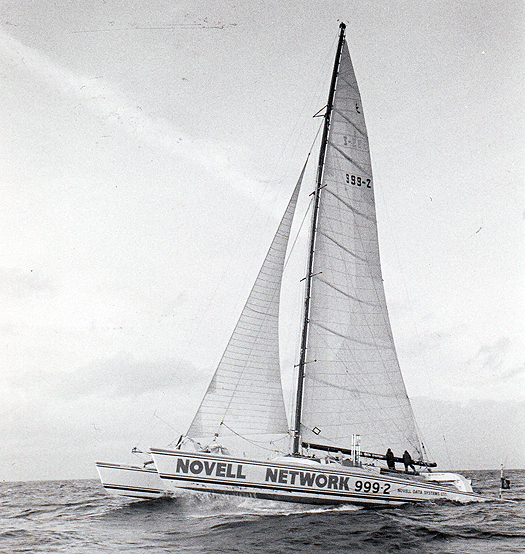
She was a brutal big beast. The 83ft Novanet was 40ft beam, heavy to handle, and very reluctant to tack. But she set a new record in November 1986.
It was, as our doughty skipper put it, an eminently beatable time. And within four months somebody was trying to do that very thing. In those days, northerner Dickie Gomes (ironically the owner since 1966 of the 1964 record holder Ainmara) had a parallel existence as a multi-hull sailor, and in 1986 he was teamed up with former police sergeant Peter Phillips on the catamaran Novanet.
This was one monster. She was 83ft long and 40ft wide, and it took half a day to tack her when the going was good. But in straight line sailing, she could get up to a merry speed, and in September 1986, with a crew large enough to think of shaping up to sailing this eccentric giant, they set off from Belfast Lough. They went clockwise in a brisk west to nor'west breeze, which had enough north in it to let them lay down to the Fastnet, where things were looking good, as they were still only 20 hours on their way. But then the huge mainsail split, and that was that for the time being.
It was November before they could have another go. If you think the prospect of sailing round Ireland in March is grim, don't even think about November.....fourteen hours of darkness, and the winter winds in crazy mood. But in another west to nor'west wind pattern, it went well until they were past Achill Island in a rising wind and a freezing front went through to cause a crucial veer which made weathering the Black Rock a very dubious proposition. Yet their awkward big boat wouldn't have tacked in the deteriorating conditions. Either they ran her off, probably to beach her, or hoped they'd just enough clearance to scrape by the Black Rock's lethal offliers.

The crew of Novanet after her successful challenge in November 1986 were (front row left to right): Dickie Gomes, Brian Buchanan, Brian Law and Peter Minnis, back row: Peter Phillips, Enda O'Coineen, (Richard Price of Novanet), Paul Hargreaves, Greg Peck and Bob Bradford. Photo: W M Nixon
They still don't really know how they did it. But with maybe only inches to spare, Novanet got past the Black Rock. This slightly freed her to clear Eagle Island and Erris Head, and after that it was off like a scalded cat under headsail only in a Force 10 past Tory and Inishtrahull and Rathlin Island, with the wind veering even further to speed them down to Belfast Lough and a new record average 10.05 knots. At least the Round Ireland Record was finally through the ten knot barrier. But still nothing sensational, you might reasonably think. Yet it stood for nearly six years. However, when it was toppled in September 1993, it was done so in very convincing style.
Con Murphy and Cathy MacAleavy of the National YC were multi-hull enthusiasts who managed to convince new-to-the-scene American sailor/adventurer Steve Fossett that he should bring his decidedly hot 60-ft trimaran Lakota to Dun Laoghaire for an early Autumn crack at the round Ireland record in 1993. Fossett had Dave Scully as his partner in the boat, and they also had up-and-coming multihull star Brian Thompson with them. They signed on Con and Cathy to bring crew numbers up to five, as many as they felt was needed for a boat which in her elegant way was as light as British Airways and Novanet had been heavy.
They'd expected to wait a while in Dun Laoghaire, but as their overall time window was narrow, when a deepening low settled into a course straight at Ireland from the southwest, they decided to ride it almost immediately. Not an ideal scenario nowadays, but don't forget that twenty years ago, they were trying to beat an average of only10.05 knots, and with a slippy boat like Lakota, they could cut themselves a bit of slack.
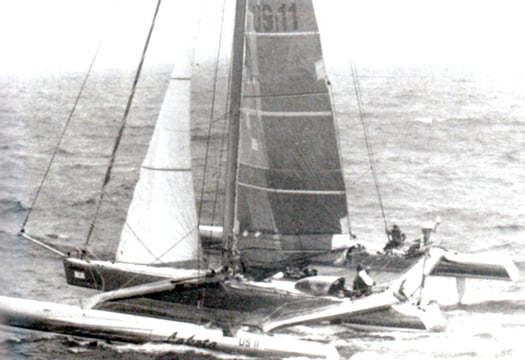
Lovely weather for record-breaking. Lakota sets off in successful pursuit of the Round Ireland record, September 8th 1993. Photo: Air Corps
The conditions when they went off on Wednesday September 8th 1993 were dreadful for yachting, but perfect for record breaking. In a mighty cloud of spray and spume and rain, under shortened canvas, they zoomed north in a horribly wonderful sou'easter. And while the Irish land lay under the heavy rainclouds of this still energetic low, Lakota streaked on past Donegal under clear night skies and south past the coast of Connacht.
Because the weather had been developing so rapidly, this meant that off Galway's west coast they were crashing into old head seas from the southwest which threatened to damage the boat. And the crew too. Con Murphy, trying to grab some sleep in a bunk down aft, found himself hurled forward along the length of the accommodation. It's beyond imagination to visualize the loads created by slamming into seas like this at these speeds, but Lakota held together.
On both the south and west coasts they had to endure the calm patches which almost inevitably develop when you are using a low pressure area centred over Ireland, with the wind drawing off the land. They came to a stop at the Old Head of Kinsale, and then again at Wicklow Head. But quite soon they were going again, and there was time in hand and then some. The Kish was put astern again after 44 hours 42 minutes and 20 seconds an average of 15.84 knots. It's a record which has stood for 19 years, four months and 12 days. Will it still be standing on Monday?
Yes it will! Message received at 07.18 on Saturday:
Dear Chris,
We will not attempt the record this time, we are aiming back to Lorient. Conditions are "almost" ok, but we prefer to play the safe decision.
Hopefully we will come back later in the year, in better conditions. All our team thanks you a lot for all your efforts, we regret we won't see you but it will happen later. Best regards. Sidney Gavignet, Skipper MOD 70 Musandam

The record holders. Con Murphy, Cathy MacAleavy, the late Steve Fossett, David Scully and Brian Thompson, crew of Lakota round Ireland, September 8th to 10th 1993
Comment on this story?
We'd like to hear from you on any aspect of this blog! Leave a message in the box below or email William Nixon on [email protected]
WM Nixon's Saturday Sailing blog appears every Saturday on Afloat.ie
Follow us on twitter @afloatmagazine and on our Afloat facebook page




























































